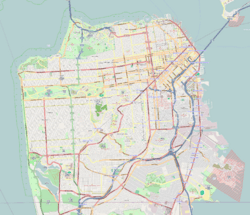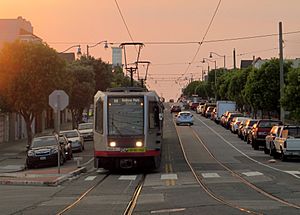Oceanview, San Francisco facts for kids
Quick facts for kids
Oceanview
|
|
|---|---|
| Country | |
| State | |
| City and county | San Francisco |
| Area | |
| • Total | 0.308 sq mi (0.80 km2) |
| Population | |
| • Total | 7,010 |
| • Density | 22,760/sq mi (8,788/km2) |
| Time zone | UTC-8 (Pacific) |
| • Summer (DST) | UTC-7 (PDT) |
| ZIP code |
94112
|
| Area codes | 415/628 |
Oceanview is a neighborhood in the southern part of San Francisco, California. It started as a community in the 1910s. Its first center was at Sagamore Street and San Jose Avenue.
Today, Oceanview is surrounded by Orizaba Avenue to the west. Lakeview Avenue is to the north. Interstate 280 is to the south and east. Other neighborhoods nearby include Ingleside and City College to the north. Cayuga Terrace is east. Daly City, California and the Outer Mission are south. Merced Heights is to the west.
In the middle of Oceanview, you'll find the Oceanview Playground. There's also the Minnie and Lovie Ward Recreation Center. These are located between Plymouth Avenue, Capitol Avenue, Lobos Street, and Montana Street. The Ocean View Branch Library is at 345 Randolph St. The neighborhood is served by Muni Metro Routes M, 29, and 54.
A Look Back: Oceanview's History
Oceanview has a long and interesting past. Some local people even call it "Lakeview." In the mid-to-late 1800s, many Italian, Irish, and German families lived here. The area was a train station for trips between San Francisco and San Jose. The San Francisco and San Jose Railroad owned the line, but Southern Pacific bought it in 1868.
After World War II, Oceanview became one of the few places in San Francisco where African-American families could buy homes. In the 1960s and 70s, more African-American families moved here. They came from neighborhoods like Western Addition and Bayview. This happened during a time of big changes in those areas.
Until the mid-1990s, more than half of Oceanview's residents were African American. In the early 2000s, housing prices here were lower than in other parts of the city. This brought in new families from Asian, Latino, and Caucasian backgrounds. This made Oceanview one of San Francisco's most diverse neighborhoods.
There was once a lake called Lake Geneva on Geneva Avenue. It was located down the slope from the eastern side of Oceanview. A creek flowed through this area and by Glen Park. It continued under what is now the Mission Street viaduct. Another part of the creek started near Cayuga Avenue and Regent Street. It joined the main creek under the Mission Street viaduct. The creek became wider between Niagara and Geneva Avenues, forming Lake Geneva.
Who Lives Here: Oceanview's People
Oceanview is a mix of different cultures and income levels. This is partly because of recent changes in the neighborhood. Asian residents now make up the largest group. This is different from the 1960s-1990s when African Americans were the majority.
However, many blocks near Broad and Randolph Streets still have a large number of African-American residents. For example, in the early 2010s, the block near Orizaba Avenue and Garfield Street was 54% Black. This was the highest concentration in Oceanview. According to the 2010 Census, Oceanview was 44.68% Asian, 22.99% African American, 20.36% Caucasian, and 14.1% Latino.
Changes and Improvements in Oceanview
During the 1990s and 2000s, many African-American families moved out of San Francisco. This was due to the rising cost of living. Also, some areas had higher crime rates and struggling schools. Oceanview was one of these areas.
By the early 2000s, serious crime in Oceanview had gone down a lot. A local group called Neighbors In Action worked with the police. They helped reduce street crime linked to gangs. A long-time resident named Minnie Ward was very important in these changes. She worked hard with her husband to improve the neighborhood in the early 1990s.
Minnie (who passed away in 2005) and her husband Lovie (who passed away in 2003) were honored for their efforts. The Oceanview Park recreation center was rebuilt and renamed the Minnie and Lovie Ward Recreational Center. This honored their work in making Oceanview a better place.
A new library opened at 345 Randolph Street in June 2000. It replaced a smaller reading room that was at 111 Broad Street. At 117 Broad, Engine Co. No.33 is an old firehouse from the 1890s. It has been restored and offers tours on an antique fire engine.
Not many new businesses have opened on the Broad-Randolph commercial street. However, in March 2012, Donald Andrews, an Oceanview resident, opened Dream Team. This was the first new business on Broad Street in almost ten years. It is a clothing store.
Even with improvements, Oceanview has still faced some violence related to gangs. In December 2012, residents and the Inner City Youth Center asked for a police substation to reopen. This was because of more violence in the area. Broad Street continues to have some of the highest rates of violent crime in the city. In early 2017, there were several shootings and homicides near Broad and Plymouth Streets.
As of 2013, many people are choosing to buy homes in Oceanview. This is because homes here are often less expensive than in most other San Francisco neighborhoods. Housing prices in Oceanview continue to go up each year. From 2012 to 2013, the average price of houses sold in Oceanview increased by 6.3%. The number of sales also went up by 66.7%. The average price per square foot for a house in Oceanview was $484, which was a 12.8% increase.



